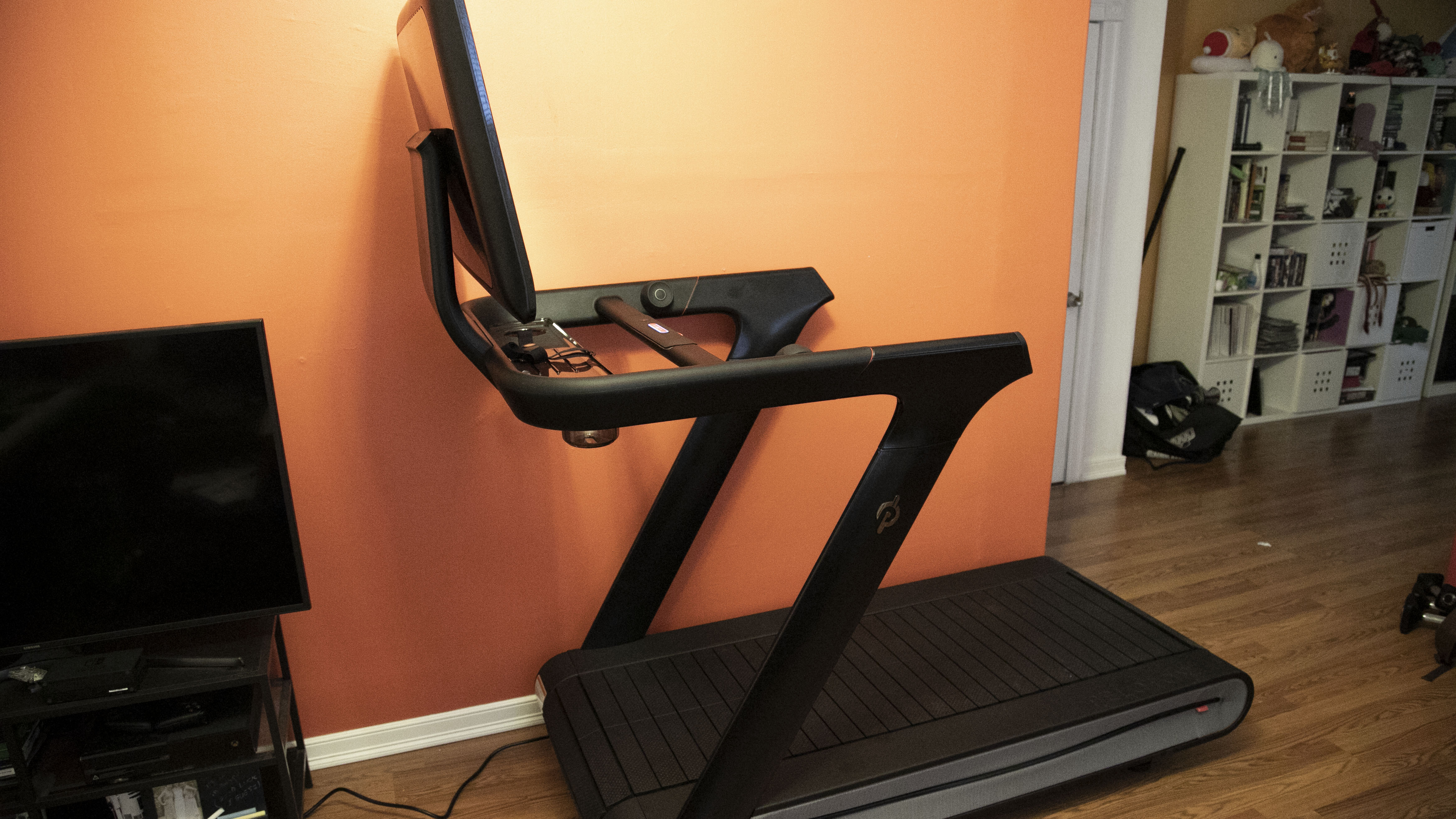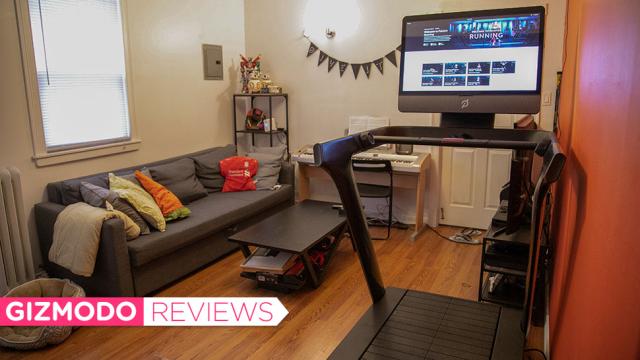Going for a run in the winter is brutal. Your ears freeze, the air burns your lungs, and if you prefer indoor workouts at the gym, getting out of a warm bed and outdoors to get there requires excruciating effort. But is the convenience of a home gym worth shelling out for a treadmill, let alone one that costs over $US4,000 ($5,629) like the Peloton Tread?
Editor’s Note: We don’t have Australian pricing and availability for this yet.
Introduced at CES 2018, the Tread comes from the same maker of the popular Peloton Bike, which was sort of like SoulCycle meets Netflix. With the Tread, you get on-demand classes on a beautifully crafted exercise machine. Whether it’s worth it depends on a few things. Do you have a giant house and is there a huge pile of cash hidden in it somewhere? Are you feeling generous? Can I have both?

Peloton Tread
What is it?
A treadmill that's like Netflix for fitness
Price
Starts at $US4,295 ($6,044)
Like
Classes for all fitness levels. I don't have to go outside in winter.
No Like
Expensive. Not great for apartments.
But in all seriousness, the thing about exercise is that you only feel good after you’ve done it. Unless you’ve got injuries or other bodily ailments, the hardest part about exercising is often finding the motivation and time in to do it. The second hardest part is doing it the right way to prevent injury and get the best results, especially if you’re a beginner.
In its ability to maximise the efficacy of your workout, the Peloton Tread is excellent. Compared to other home treadmills, it comes with a 81cm HD touchscreen so you can stream live and on-demand classes. There are over a thousand classes you can choose from, plenty of instructors with their own personalities, and a good number of metrics you can track straight from the screen, like heart rate (though this requires a compatible ANT+ heart rate monitor), distance, and pace. You can also automatically share your workouts to Fitbit and Strava, if you’re already hooked into those platforms.
The classes are the best part. I’ve been running for years, and like anyone else, my progress has confronted ruts and plateaus. (Full disclosure, I also have periods where I fall off the fitness train and onto my potato chip-stained couch.) Part of the problem is getting bored with apps like Runkeeper or doing the same few fixed interval workouts. On the Peloton, I tried out beginner, intermediate, and advanced classes and was pleased to find they were all challenging for their skill levels, but not to the point of immediately throwing up my arms and giving up, or waking up in immense pain the next morning. Over the three weeks of testing the machine, I found myself improving at a faster speed than when I would look up running workouts online.
The workouts vary in length, duration, and even exercise type depending on the type of run you want. You can opt for shorter 20-30 minute Fun Runs and high-intensity interval training (HIIT), up to 45-minute intervals or 60-minute heart rate zone-based endurance runs and marathon prep. There are also options for power walking, or strength (or as Peloton calls them, “bootcamp”) workouts that require a mat and some free weights.
An intermediate 30-minute hills run I tried involved a short warmup with jogging, followed by instructor-led intervals of increasing difficulty. For example, you might start with a jog somewhere between 3-4.5 mph, amp up to a straight run somewhere between 5-6.5 mph at an incline of about 6-9 per cent for about 90 seconds, and recovery jogs/walks at a 1-2 per cent incline at half the speed. You have the option of additional 5-minute warmups and 10-minute cool down classes, on top of the mild stretching each workout ends with.
Peloton also gets kudos for instructors focusing on techniques and explaining things like why you might want to run at chicken-like 180 steps per minute as opposed to leaping like a gazelle through the air. Things like cadence, pace, and proper running form aren’t new concepts, but they can be hard to grasp for plenty of people just starting a Couch to 5K program or trying to make good on New Year’s Resolutions. Beginner classes, in particular, have an emphasis on proper form, as well as warmups and cooldowns. It also helps that every instructor injects some degree of positive perkiness. (Even if I occasionally find their musical choices to be questionable.) There’s a good chance you’ll find someone to your taste, and it is helpful to have someone tell me when to kick it up a notch, when to give myself a break, and what sort of exertion level I should be aiming for.
But that’s the thing. As much as I enjoyed how simple it was to roll out of bed and hop on the Peloton Tread, the machine itself isn’t necessarily worth the $US4,300 ($6,051) minimum price tag. (Packages go up to $US4,844 ($6,816), or $US202 ($284) a month with financing, not including subscription fees.) Sure, it’s well-constructed, beautiful machine made from carbon steel. It’s easy on my knees and shins when I run on the 59 individually mounted, rubber-coated aluminium slats. The handrails feel nice when I’m hunched over and wheezing from a hard workout. It’s also gigantic.
It took three Peloton delivery men to wrestle this thing into my moderately sized, only somewhat cluttered apartment in Brooklyn. They uttered phrases like, “This thing is like a tank,” and “Oh god my back.” Which makes sense because this thing has a footprint of 1.83m by 0.82m, and weighs a whopping 206kg. My janky floorboards bent a little under the weight. It dominates my living room. We had to move our TV distinctly off center to accommodate it. My tiny dog sometimes stares at the large contraption in senile bewilderment.
It’s also extremely loud. Of course, you’d never expect a treadmill to be quiet, but the Peloton Tread still isn’t the most subtle device. The ground shook when I ran, and things on my coffee table came precariously close to falling off. That makes sense—this thing goes up to a speedy 21km/h. But with its large size and hefty weight, it cements that the Tread isn’t suited to apartment living. I could hear when my roomie was going for a run, and I imagine my neighbours could too.
These issues are not necessarily unique to Peloton—most high-quality treadmills are going to be loud, big, and heavy. It just limits who can benefit from this thing. That’s a bummer because there are things I liked about the machine. Screen aside, the two incline and speed rollers on the left and right handrails are intuitive to use. Spin them forward, and you’ll increase the incline or speed, while rolling it back will do the opposite. It certainly beats hitting a speed or incline button, and then awkwardly cranking it up using a rocker while running. The rollers also include a jump button in the middle, so you can quickly increase the speed to the next level or incline percentage. For example, if you’re jogging at a speed of 8km per hour, but want to get up to 7 mph, you can just push the button three times.
Another deft design touch is the Tread’s safety key. Basically, it’s a failsafe that if removed will immediately cut power to the treadmill. In the morning, my coffee-deprived arse has fallen face-first on a treadmill, so I am that nerd who always clips the safety key to my belt. It’s not that it’s so much better than the cheaper treadmills I’m used to—but the magnetic key wraps neatly around the middle bar for easy storage instead of just dangling from the machine.
But none of these nifty design choices makes up for the price. No treadmill is going to be cheap, per se, but you do not have to shell out a minimum of $US4,300 ($6,051). And that number jumps up if you decide to opt for the exercise mat, dumbbells, or heart rate chest strap. Plus, that’s not including Peloton’s extra $US40 ($56) per month subscription. This is extravagant when you can find a barebones manual treadmill around $US200 ($281) on Amazon, and decent motorised ones in the $US1,500 ($2,111) to $US2,500 ($3,518) range. Sure, top quality treadmills will cost somewhere above $US3,000 ($4,222), but again, those don’t come with a monthly subscription, and one of the perks of home exercises is eliminating pesky fitness fees.
NordicTrack has some similar treadmills to the Peloton that are marginally cheaper. Its X22i Incline Trainer, for example, is about $US2,800 ($3,940) and also comes in with built-in monitor for HD on-demand classes. And there are competitors apps like Studio and Zwift which let you take classes with existing treadmills over Bluetooth. Both cost $US15 ($21) a month and have their quirks. Studio’s classes are audio-only, while Zwift lets you run in virtual landscapes, but requires you to buy a foot pod.
If the Peloton Tread’s best feature is its content, then there’s no reason you can’t download its digital app for iOS or Android for $US19.49 ($27) per month—which is still pricier than say Zwift or Studio but not by much if you find yourself actually liking Peloton’s content. You miss out on live classes, but that’s a minor sacrifice. It’s way more cost effective and delivers a similar experience if you just subscribe to the app and use your gym’s crappier treadmills. The app also gives you access to cycling, outdoor running, and floor exercises, on top of the “bootcamp” strength training workouts you get with the Tread.
Ultimately, Peloton delivers a quality experience with its treadmill. It just comes down to how much space you have, how fat your wallet is, and how much you really hate going to the gym. I suspect for most of us, some combination of the app and a gym subscription should suffice just fine.
README
-
Live and on-demand classes are the best part. Great instructors, multiple skill levels and programs.
-
It is big and loud. Not for apartment dwellers unless you’re rich and have a beautiful penthouse.
-
Extremely expensive at a minimum of $US4,300 ($6,051), not including a monthly $US40 ($56) subscription.
-
That said, it’s a well-constructed and beautiful machine with lots of neat design flourishes.
